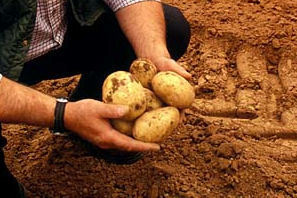 Potatoes saved from weeds by paraquat
Controlling weeds in potatoes is a problem for many farmers. Paraquat is a very useful herbicide for potatoes because it can be used to burndown weeds from before planting right up to the point at which the potato sprouts start to emerge from the soil1. This allows for weed control measures to be tailored to the weeds present. As potatoes may take up to four weeks to emerge, significant weed growth may have occurred after planting.
Potatoes saved from weeds by paraquat
Controlling weeds in potatoes is a problem for many farmers. Paraquat is a very useful herbicide for potatoes because it can be used to burndown weeds from before planting right up to the point at which the potato sprouts start to emerge from the soil1. This allows for weed control measures to be tailored to the weeds present. As potatoes may take up to four weeks to emerge, significant weed growth may have occurred after planting.
Weeds can quickly overrun potato crops if they are allowed to grow unchecked before the crop leaf canopy closes. They compete with potato plants for light, water and nutrients, so if they are not controlled weeds reduce yield and quality. In addition, large weeds entangle the crop and interfere with harvesting. Weeds may also encourage pests and diseases. Filling the crop canopy, they restrict air flow, increasing humidity under which fungal diseases, especially potato blight (Phytophthora infestans) thrive. Blight can devastate potato crops so intensive use of fungicides is needed to achieve control.
Paraquat is inactivated and immobilised immediately on contact with the soil, so cannot affect the seed potatoes, or later, the developing crop of tubers.
Sustainable potato production
2008 was the United Nations’ International Year of the Potato2. A book of guidelines for sustainable production was written to build on the experiences shared during 20083. Principles of Good Agricultural Practice recommended include:
- Managing the soil in potato fields to reduce erosion
- Maintaining or restoring soil organic matter levels
- Maintaining soil structure
- Reduce water loss and improve infiltration
All these aims can be met by reducing unnecessary soil tillage. Excessive tillage degrades soil and results in erosion on sloping terrain, eg in the foothills of the Andes in South America, the region where potatoes originated. There, the traditional way to prepare fields for planting potatoes is by ploughing and cultivating two or three times. Authorities in Colombia estimate that an average of 20 tonnes of soil are lost every year from each hectare of cultivated land across the country. In extreme cases erosion losses may reach 100 tonnes of soil per hectare. Eroded soil is eventually deposited in ditches, rivers and lakes, blocking water flow. Mineral nutrients in sediment and rainfall run-off cause algal blooms which exhaust dissolved oxygen and reduce biodiversity in affected water.
References
- Murphy, H J et al (1970). Pre and early post-emergence weed control with paraquat in potatoes. American Journal of Potato Research, 47, (7), 252-255
- UN Year of the Potato (link is external)
- FAO (2008). Sustainable potato production: guidelines for developing countries

